The term revenue operations is on the rise, from mentions from Boston Consulting Group to the growth of the revenue operations titles on LinkedIn. In fact, VP of Revenue Operations titles have increased more than 300% in the last 18 months.
But the concept of revenue operations isn’t new.
As a revenue leader who has led go-to-market (GTM) operations for over 20 years, I know that for as long as teams have been acquiring and growing revenue, there has been a need to manage the revenue process that is Revenue Operations.
So what’s changed? Getting that revenue process right was inefficient, costly, and often painful—until now.
Table of content:
- What is revenue operations?
- Why is revenue operations important?
- The history of revenue operations
- Why is there a rising call for revenue operations?
- Are there tools available for revenue operations?
- How do revenue operations differ from sales and marketing operations?
- What is the Revenue Operations Council (ROC)?
- Why implement a RevOps strategy?
- The future is revenue operations
- Improve revenue operations with Clari
What is revenue operations?
Revenue operations (RevOps) is an alignment between marketing, sales, renewals, and expansion to drive predictable revenue. It builds a framework for sharing data, allowing departments to understand how each other’s processes work.
To align in this way, RevOps teams need to focus on the following things:
- People: You must align your employees around a single view of the customer journey. Constant communication between departments ensures sales and customer success teams provide feedback to marketing on lead quality, allowing them to focus on attracting the best leads.
- Data: You need to share revenue-related information, whether that’s sales, marketing, or finance, across teams. Not silo it. Every department should have access to analytics tools and track the same metrics.
- Processes: Success in RevOps hinges on the quality of your processes. Good communication and data-sharing practices will only take you so far in large organizations, so you need a set of shared processes to fall back on.
Why is revenue operations important?
There are several reasons teams just adopt a RevOps function.
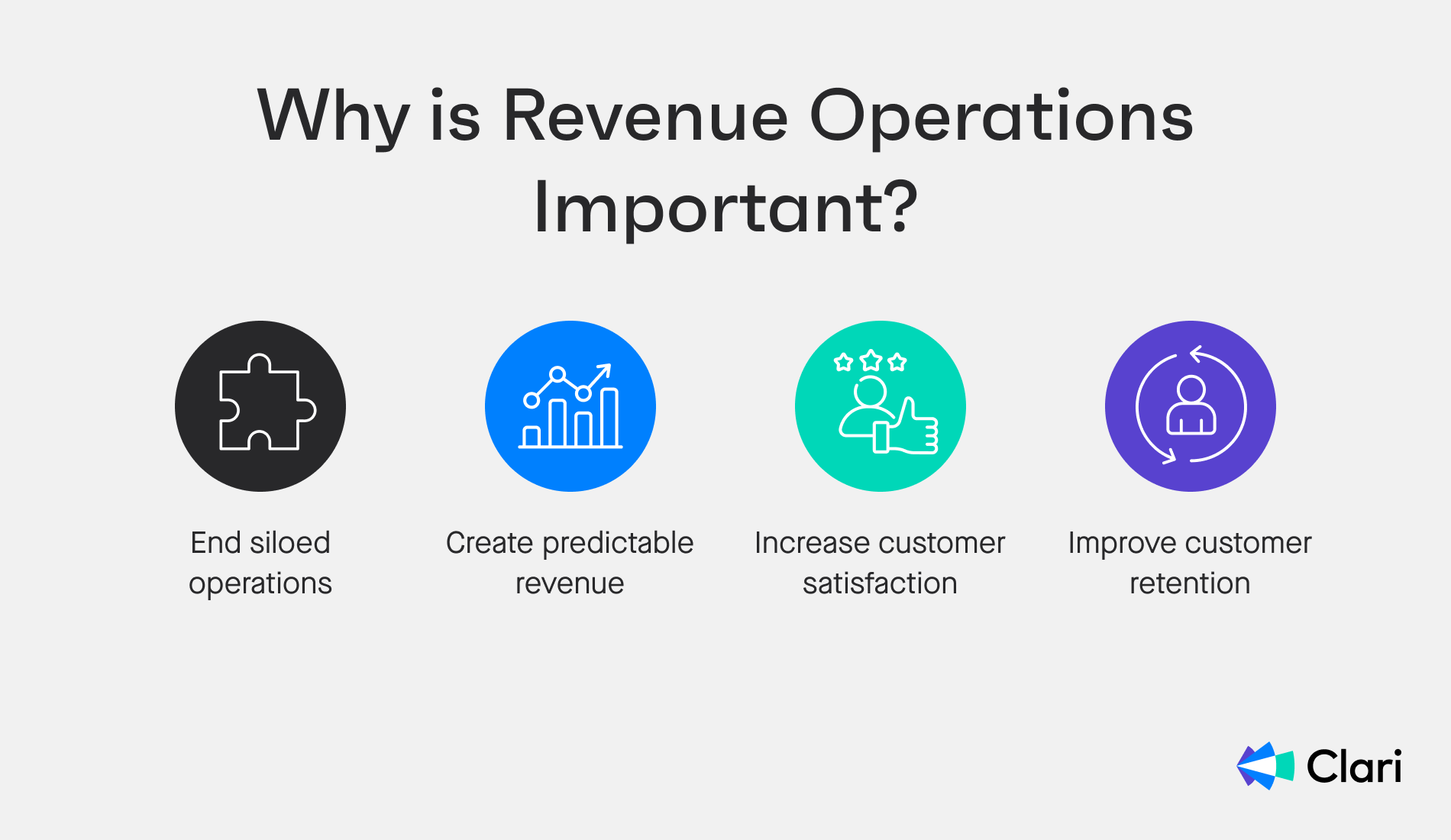
End siloed operations
In many B2B organizations, there is a gap—sometimes, it’s a chasm—between marketing and sales that can lead to dissatisfaction and, sometimes, conflict. As a result, operations, processes, and data end up siloed.
Adopting RevOps can close this gap, motivating both teams to work together towards a single goal. Collaboration happens naturally by sharing tools, data, strategies, and targets, and competition gets put aside. After all, working together to hit their goals is in both teams' interests.
Create predictable revenue
The whole point of RevOps is to turn revenue from an outcome that happens by chance into a process that can be optimized and improved. When you share data and processes, predicting how much revenue you’ll generate each quarter becomes much easier.
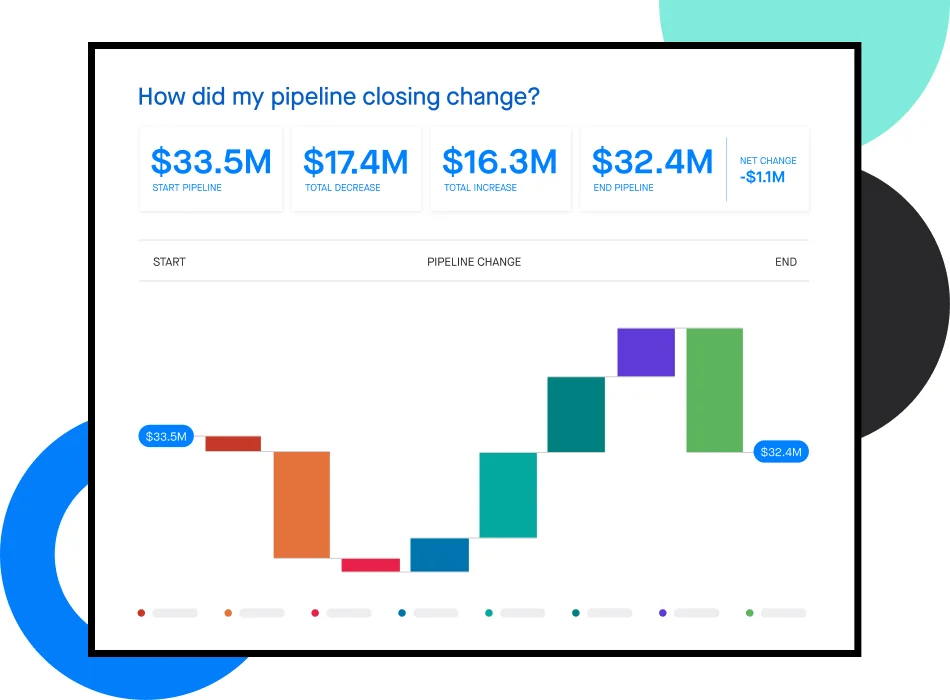
RevOps can also increase revenue. Because the process optimizes the entire customer journey, RevOps teams often uncover new revenue streams or pockets of profitable customers that sales and marketing teams can exploit. Research by Alexander Group finds that high-performing RevOps functions drive 1.6x higher EBITDA margins than their peers.
Increase customer satisfaction
The modern B2B customer has high expectations. A Gartner Survey finds that 86% of B2B customers expect you to be well-informed about their personal information during interactions.
Given the sheer number of customer touchpoints, that’s only possible when you implement RevOps processes that encourage marketing and sales teams to share data about previous customer interactions and inquiries.
The result? Customers get a positive experience across every touchpoint, from entering your funnel until closing the deal.
Improve customer retention
When there’s little to no communication between marketing, sales, and customer success, it’s hard to convey customer expectations. That means those expectations risk going unmet, and the customer will likely churn when that happens.
RevOps solves this problem and increases customer retention. Regular communication between departments keeps everyone on the same page, allowing sales teams to promote features that solve pain points and custom success teams to know exactly what users want to achieve.
The history of revenue operations
In the past, sales and marketing managers handled the operations side of things themselves. They worked in siloed departments with separate missions and disconnected experiences. Marketing didn’t know what sales was doing, and vice versa.
The two departments started sharing data in the 2000s with the advent of CRM technology, automation, and lead scoring. Terms like marketing qualified lead (MQL) and sales qualified lead (SQL) gave sales and marketing a shared nomenclature, allowing them to discuss what makes a lead good and track where good leads came from.
Data sharing continued into the 2010s, and thanks to technology that made attribution tracking easier and more accurate, marketing teams were soon able to measure their impact across the entire customer journey, including the revenue they were responsible for. This led to an even closer partnership between marketing and sales.
It wasn’t long before dedicated teams were established to track and optimize revenue, and titles like Chief Revenue Officer became common in B2B businesses everywhere. Fast forward to today, and Head of Revenue Operations is the fastest-growing job in the U.S.
Why is there a rising call for revenue operations?
You can get inspiration from these sections of the original article or keep it as is and add to it:
The term revenue operations, and the philosophy behind it, has started rising as businesses increasingly realize the interconnectedness of various departments and how silos serve no one.
This much is clear: Operationalizing growth from the boardroom to the front line requires an orchestrated effort coordinated by experienced revenue professionals who can drive transparency and accountability across the entire business.
Yes, revenue operations is a job title, but it’s less about an organizational or reporting structure and more about having comprehensive, well-defined alignment in the GTM model that cascades up and down the organization and across the entire customer journey, from the top of the funnel to customer to renewal and expansion.
It’s about making the number quarter after quarter and delivering visibility and rigor to achieve those predictable results.
Why?
Revenue teams are tasked with more demanding strategic initiatives from the CEO and the boardroom, even as they face a host of new developments across an increasingly complex buyer’s journey:
Prospects are more aware of what’s available. With the rise of technology and real-time access to information, prospects often know what they want to buy before the first call, the first download, or the first meeting. Prospects are knowledgeable, intelligent, and armed with information. Understanding this new era of the empowered prospect and continuing to find ways to drive predictable revenue is the hallmark of a well-run company.
Buyers expect a frictionless purchasing experience. Buyers expect companies to be easy to do business with and expect quick turnarounds and real-time answers. Buyers won’t tolerate jumping through internal hurdles or experiencing poor handoffs. The entire revenue team, from the executive sponsor to the rep in the field, needs to be aligned to deliver that seamless experience. This requires airtight and consistent sales processes as the buyer moves from stage to stage.
Customers expect a seamless, value-driven vendor partnership. Value, value, value. Bring value. Demonstrate value. Prove value. Drive value. Customers don’t want a vendor-client relationship. They expect a partnership. Joint efforts help them see value and be successful.
It’s not just about new logos anymore. Businesses need to not only acquire net new customers, but also to be able to retain, expand, and upsell into their existing customer base. With more businesses moving to a recurring revenue model, the need to align the end-to-end revenue process to the customer journey is critical. Alignment up and down the entire revenue team ensures a seamless flow across data, systems, processes, and teams from the earliest stages of interest through renewal and expansion.
Data and insights are key to driving transparency and accountability. Never before has the ability to have real-time, accurate, meaningful insights been more critical. The ability to make data-driven decisions, and pivot where necessary up and down the entire organization, is absolutely critical to every business. Data visibility, early, often, and always, has become a must-have in today’s revenue model.”
Are there tools available for revenue operations?
A robust software stack is the foundation for revenue operations, and several tools can help you establish and improve a revenue operations process. Here are the top tools we recommend your team adopts:
A CRM
Arguably the most important tool in your RevOps toolkit, your CRM is a single source of truth for marketing, sales, and customer success data. If you only have the budget for one, make it a CRM.
Sales and marketing automation tools
Any tools that help marketing and sales teams do their jobs more effectively are welcome as part of a RevOps tool stack.
Marketing automation platforms help marketers eliminate manual work from much of the campaign creation and management process. Sales engagement tools help reps scale personalized outreach and stay on top of the deals in their pipelines.
Analytics tools
Go beyond Google Analytics with a dedicated analytics platform that tracks sales and marketing efforts. Combining the two in one platform is vital to identify customer trends that can lead to revenue growth.
A revenue platform
Revenue platforms, like Clari, are purpose-built platforms that help you optimize revenue. While some RevOps leaders may see this as a nice-to-have addition if there’s the budget for the subscription, a comprehensive revenue platform can replace several tools in your tech stack.
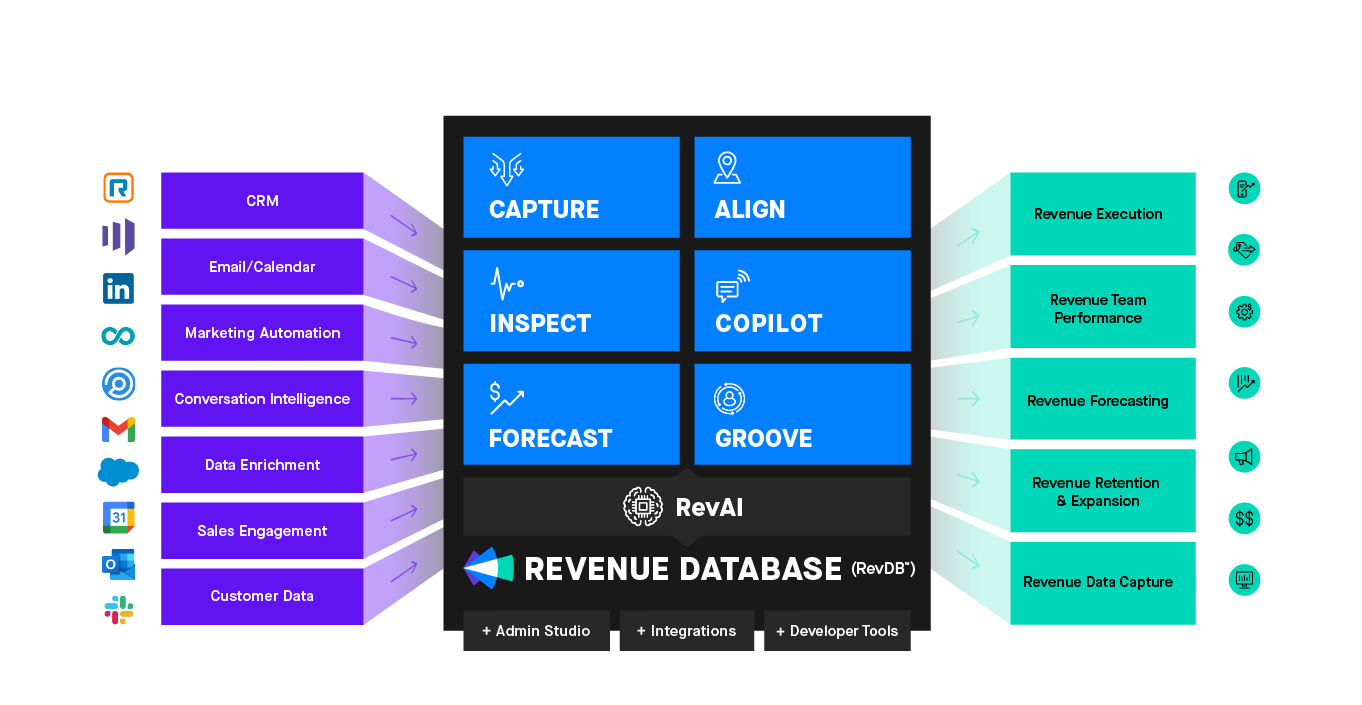
Take Clari’s unified platform, for example, which captures more data than your CRM and automates the sales process better than a sales engagement platform. It tracks your pipeline, forecasts sales figures, and reports on everything.
Want to see Clari in action? Book a demo today.
How do revenue operations differ from sales and marketing operations?
There is some overlap between RevOps, SalesOps, and MarketingOps. Still, the latter two are far more specialized and lack the cross-departmental collaboration vital in RevOps.
Sales Operations, for example, focuses on optimizing sales processes, delivering sales training, increasing rep productivity, and managing the sales pipeline.
MarketingOps, on the other hand, is responsible for supporting the marketing team. It focuses on things like marketing automation and data management.
You can think of both SalesOps and MarketingOps as separate pieces of the RevOps puzzle. They can’t achieve everything independently, but working with FinanceOps and CSOps (customer success operations) means you optimize the entire customer journey.
What is the Revenue Operations Council (ROC)?
In 2020, leading tech companies, including Zoom, Workday, Okta, Qualtrics, Alteryx, and McAfee, formed a coalition known as the Revenue Operations Council (ROC) to provide market education on strategy, best practices, and professional development to the worldwide Revenue Operations community.
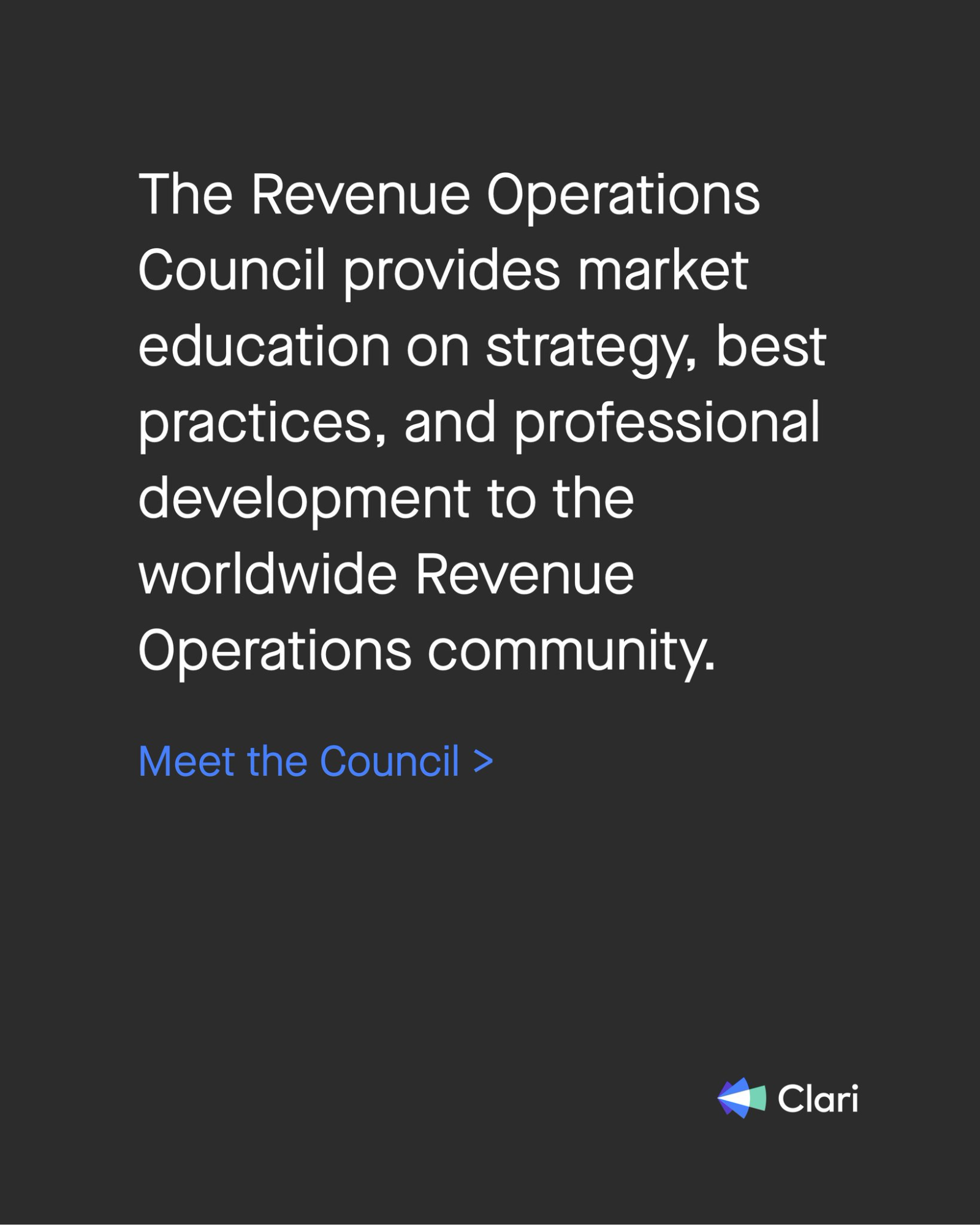
While RevOps is nothing new, this moment marks a milestone in the formalization of the Revenue Operations community. It’s a signal to the world, the industry, and every revenue operations professional that this movement is real, with real leaders at real companies making a real impact.
In the paper, ROC members share how they’re operationalizing growth from the board to the CEO down to the front line through next-level metrics to drive strategic initiatives for the business.
Why implement a RevOps strategy?
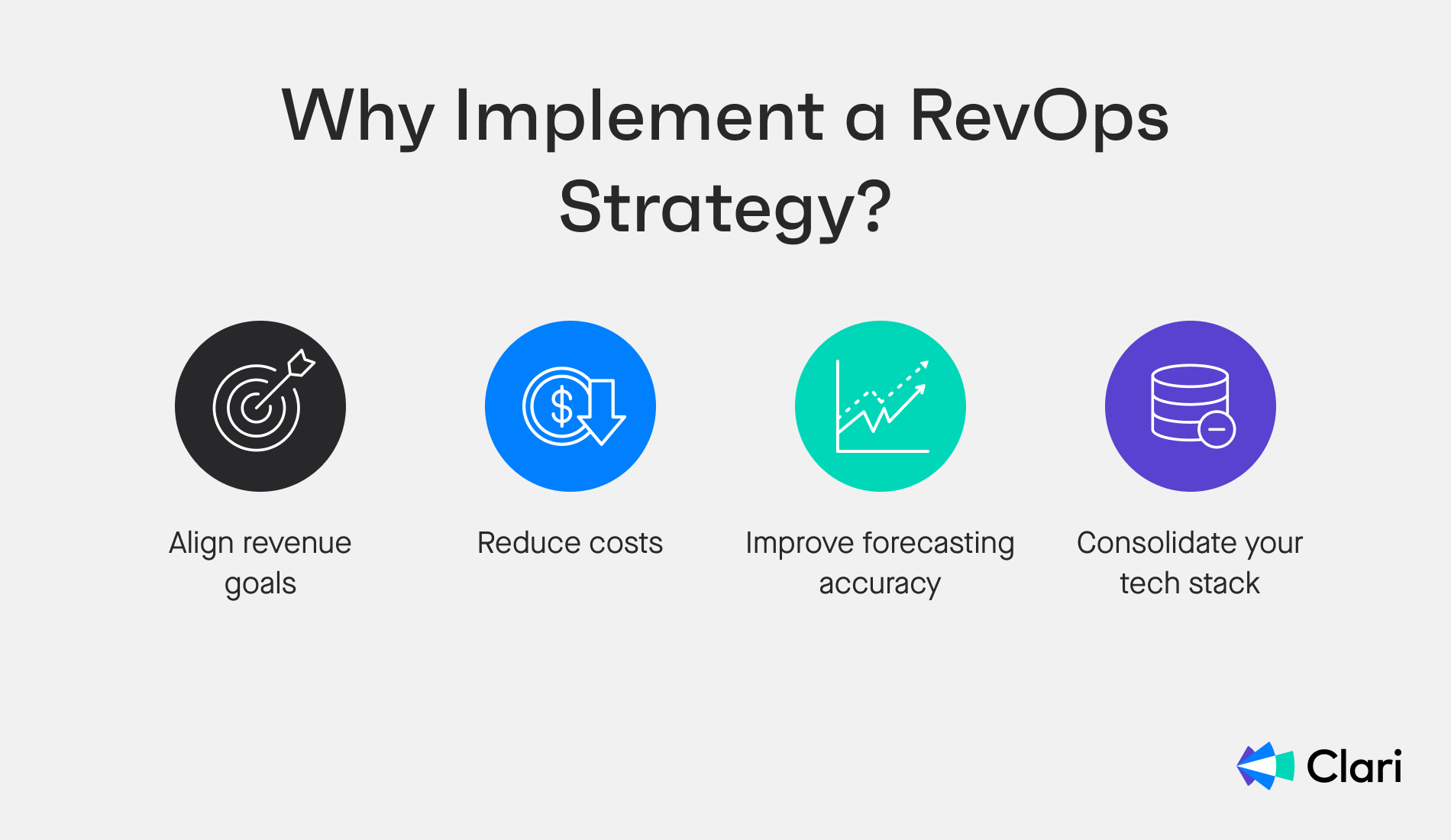
Align revenue goals
Sales and marketing teams shouldn’t be pulling in opposite directions. But that happens when they don’t share data or a vision of what it takes to drive revenue. For example, marketing could be focused on top-of-the-funnel metrics like eBook downloads that don’t contribute to revenue targets or on attracting leads that they think are qualified but that never convert in reality.
RevOps fixes this problem by improving department communication and encouraging everyone to get on the same page.
Reduce costs
RevOps reduces both your operational costs and customer acquisition costs.
Better collaboration between marketing and sales means you should be able to trim your budget by canceling some of the dozen or so tools each department uses — more on that below.
But it can also lead to efficiencies in your marketing and sales efforts, which means less time and money is wasted attracting poor-quality leads. Marketing teams start to understand exactly which leads convert best and have the highest customer lifetime value, allowing them to focus on this persona and reallocate resources away from less profitable customer profiles.
Improve forecasting accuracy
When you remove silos and create a single source of truth, it becomes a lot easier to start forecasting how much revenue your organization will generate. Shared goals and processes make it easier to rack deals and predict how much pipeline will convert in the coming months and years.
The upshot of this is that it allows stakeholders to make budgetary and resource decisions in the interest of every department. Rewards and bonuses can also be split fairly, leading to increased satisfaction across the company.
Consolidate your tech stack
Teams that don’t implement RevOps processes tend to pay for too many tools, leading to confusion and siloed data.
RevOps forces marketing and sales teams to consolidate tools into a single stack everyone uses. It prevents budget waste and makes it much easier to share data across departments. Crucially, teams benefit from a single source of truth for all revenue-related information, making it much easier for each department to make data-backed decisions.
The future is revenue operations
So what does Rosalyn Santa Elena, our former Head of Revenue Operations and current Founder and Chief Revenue Operations Officer of The RevOps Collective, think:
“I believe more businesses will realize the importance of the revenue operations framework and start to pivot towards this critical approach to their go-to-market model. With this important shift, the value of RevOps will continue to be highlighted and elevated as the strategic differentiator that it is, aligning the GTM model across key areas, including: strategy, objectives, metrics, data, processes, systems, and people.
The old structure where the different revenue-generating teams could work in silos is no longer effective. It is antiquated, outdated, and inefficient. Companies looking to drive end-to-end revenue growth, new customer acquisition, and install base expansion need to break down these silos and ensure alignment up and down the entire GTM organization.
And with that, business teams will increasingly look to the thought leaders and operational practitioners who have been successful at creating this end state to help lead, guide, and define the strategies, the methodologies, and the best practices to help others achieve the same.”
Improve revenue operations with Clari
From better, more predictable revenue to increased customer satisfaction and reduced costs, there are plenty of reasons to invest in RevOps.
But only one purpose-built platform can help you measure and optimize every revenue function: Clari.
Clari’s Revenue Operations Platform unifies sales, marketing, and customer success efforts, gives RevOps teams total visibility across your organization, and automatically spots risks and opportunities in your pipeline.
Find out more and see Clari in action by booking a demo.


